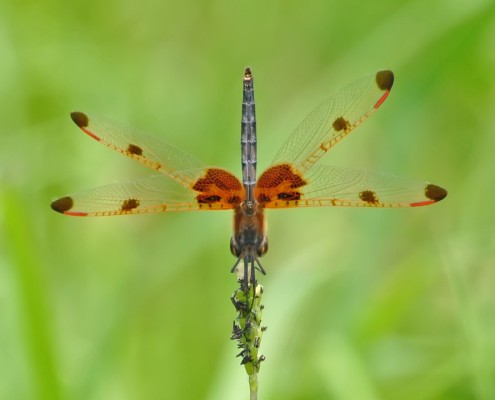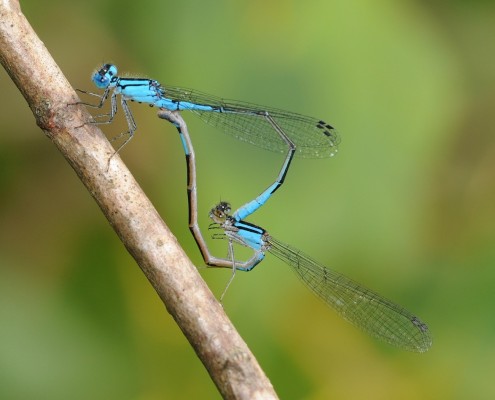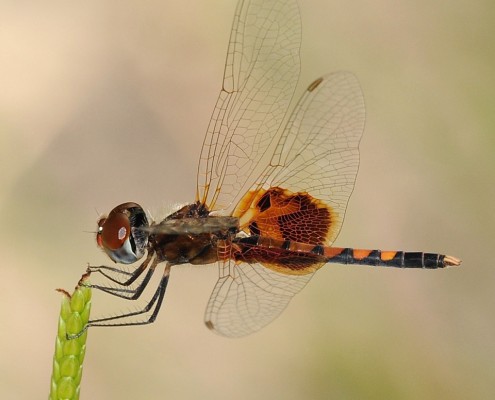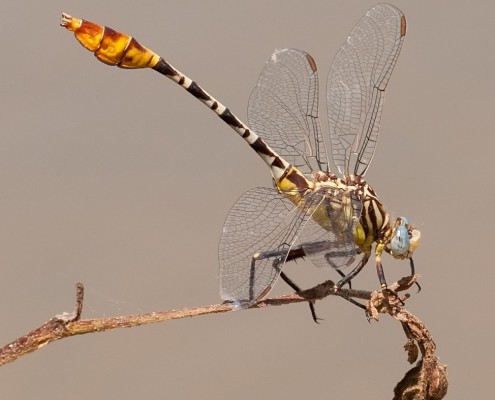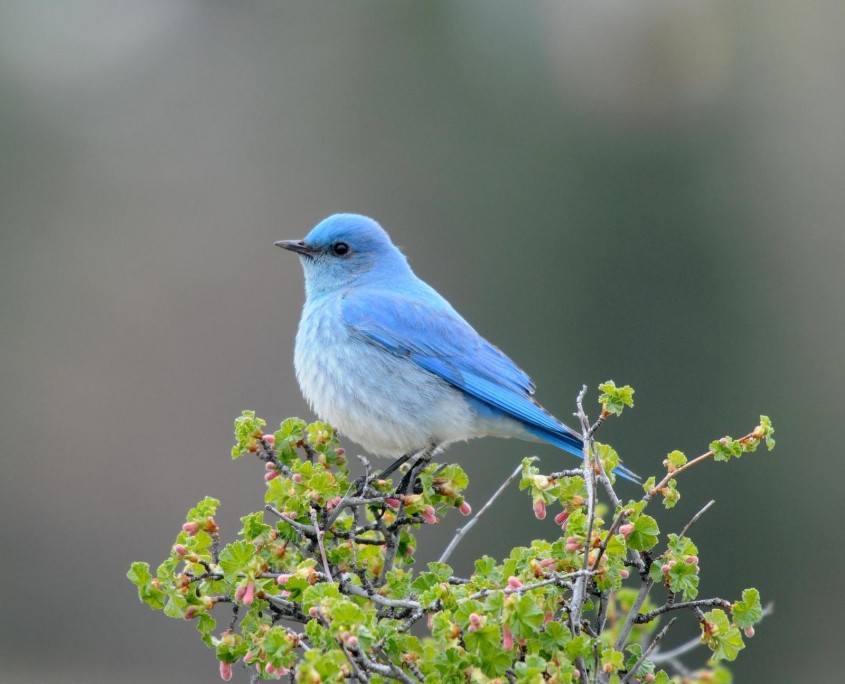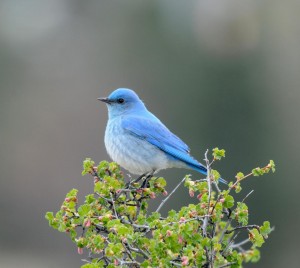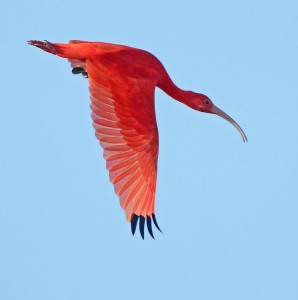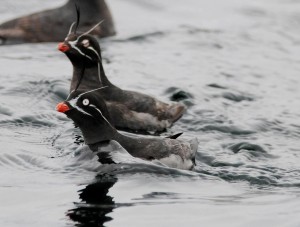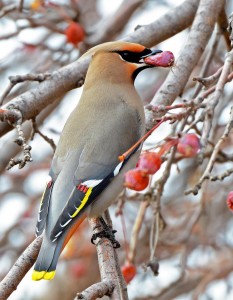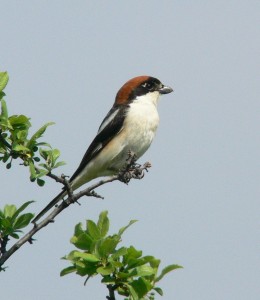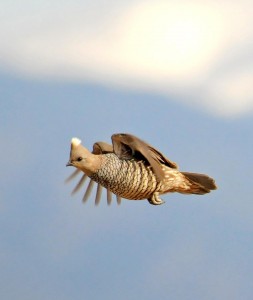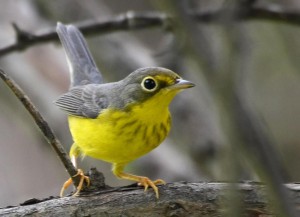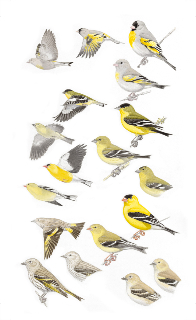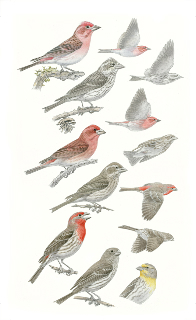Marion Dobbs – Ode photographer Extraordinaire
Marion has always been attracted to biology, natural history, and the outdoors. She doesn’t know why – neither of her parents were, nor any other relatives of their or her generation. But she has soldiered on alone.
Her education and training included an undergraduate degree in zoology, a master’s degree in conservation ecology, and a doctorate in biogeography. If she could have made a career as a professional student, she would have. She tried.
Marion actually worked for pay for several years and took even more years off to raise two children. Midlife crisis, combined with empty-nest syndrome, sent her back to school followed by another period of employment. Now she spends much of her time wandering in fields, slogging through swamps, wading in rivers, and digging in streams in search of her study target – dragonflies. When she’s not out doing that, she’s home bending over a hot computer maintaining a variety of state databases, keeping up with her field notes and email, editing photos, doing a bit of reviewing for Odonata Central, making maps, and designing websites for herself and for the occasional other.
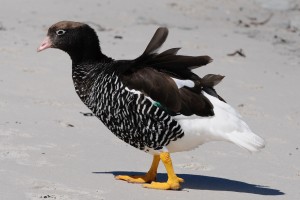
Kelp Goose — Marion is also a great bird photographer!
She has been extremely fortunate to explore many parts of our country on foot and by car and to travel on all continents excepting Antarctica, primarily on bird, natural history, and/or photography-oriented trips. She is proud to state that she has seen House Sparrow on all of those continents.
Marion’s writings and photographs appear in a number of esoteric journals, books, and field guides read only by the select few and on various insect identification and conservation websites popular chiefly with geeks of her own sort.
She has five grandchildren, none of whom, to date, show more than a passing interest in nature. She is thankful for the digital age; it enables her to maintain contact with those who do share her unending curiosity about the world she lives in.
See more of Marion’s great photography on her blogs:
Dragonflies and Damselflies (Odonata) of Georgia, the southeastern U.S., and beyond
MAMOMI – Travels, Nature, and Oddments of Various Kinds
March Photographer of the Month
Steven Mlodinow was born in Chicago where his dear older brothers, Michael and Len, started him off on his path to obsession. Blame them! He was later mentored by members of the Evanston Northshore Bird Club, especially Charlie Clark and Pat Ware, to whom he owes an enduring debt for their kindness and guidance. Most of what is good about Steve’s approach to birding can be laid at their feet and those of Bill Tweit.
The photography bug started with a videocamera and then a Panasonic Lumix ultrazoom around 2005, followed by a series of Nikon cameras (D200, D300, D7000) using a Sigma 50-500 mm lens starting in 2008. Steven was the Oregon-Washington regional editor for North American Birds for 10 years and for Colorado-Wyoming for 3 years. He has served on the Washington Bird Records Committee for 10 years and was author/editor of several books, most recently Birds of Washington, which was published in 2005. His photographs appear in several books, including the Stoke’s Guides and Dennis Paulson’s dragonfly guides.
He would like to thank his patient companions, who endure his lens-bearing chases of creatures great and tiny.
January Photographers of the Month
We are excited to announce Pete Myers and Keith Hansen as the January photographers of the month.
Pete Myers has been a birder as long as he can remember, growing up near Baltimore, Maryland, and various countries in Central and South America. He has been photographing birds for over 40 years now. After receiving a Ph.D from Berkeley researching shorebirds in Argentina, along the sandy beaches of northern California, and the Alaskan tundra, Pete traveled to the Academy of Natural Sciences of Philadelphia, where he worked until leaving to become Senior Vice-President for Science at the National Audubon Society.
Various other opportunities distracted Pete from birds and photography for nearly two decades, but he was drawn back in with the new possibilities of digital photography. Pete is also one of the creators of BirdsEye and BirdLog. In addition to BirdsEye, Pete’s images and writing about birds have been published in numerous venues, including Audubon, Natural History, and American Birds magazines, and was featured on the cover of Audubon’s American Birds four times.
Keith Hansen took up illustrating birds in 1976, his senior year of high school. He explored much of California as a young man, expanding his explorations toward Mexico and Central America, the tropical Pacific aboard a NOAA research vessel, and then a foray to the Andes, the Galapagos, and the Amazon of Ecuador. As a visitor and volunteer for the Point Reyes Bird Observatory, he was introduced to the breathtakingly beautiful region of Marin County’s Point Reyes Peninsula. Keith has created bird illustrations for books, scientific journals, magazines, newsletters and logos. His most recent endeavor has been a 14-year project illustrating a book entitled, Birds of the Sierra Nevada: Their Natural History, Status and Distribution authored by Ted Beedy and Ed Pandolfino. Keith lives and works in Bolinas, where people are welcome to visit his studio and view his originals, and purchase prints. Below are two of his plates from that new guide.
If you are interested in seeing their artwork in person, Pete and Keith have an exhibit opening January 12 at Commonweal in Bolinas, CA. There is also an Artist reception on January 17th from 3-5pm.
Details about their exhibit can be found at the event page.
December Photographer of the Month
Please join us in congratulating Jack Jeffrey, this month’s photographer of the month. From a young age, Jack always had a strong affinity for nature. Today, as a wildlife biologist and nature photographer, Jack is still exploring forests, crawling through mud and climbing trees to capture in photographs the essence of the flora and fauna that he loves so much.
Jack has made the Pacific his home for the last 50 years, where he has worked as a wildlife biologist specializing in island ecosystems. In his spare time, Jack is dedicated to photographing the rapidly changing natural history of Pacific islands before many of the native species are lost forever. As a photographer, Jack brings to his images the knowledge gained through years of observation and study of endemic island species. Combining a naturalist’s curiosity with a photographers’ patience and technical skill, he is able to capture the spirit of rare birds, plants and other natural treasures, within his wonderful photographic images. Jack also offers birding and photography tours of the Hawaiian Islands.
Jack contributed the only photo in BirdsEye of the now extinct Po’ouli. In his own words:
In January of 2002, I had an opportunity to assist researchers on Maui, as they tried to capture the last of the remaining Po’ouli known to exist. This Hawaiian Honeycreeper species was only discovered in 1974. By 2002 only 3 birds remained in a remote rain forest in the Hanawi drainage on the east slopes of Haleakala on Maui. I was in the area for 10 days and only had two contacts with the bird during that time.
One morning, while photographing forest birds coming to a native mint in flower, I thought I heard the call of a Po’ouli nearby. I found the bird high in an Ohia tree about 100 ft away. I was able to get a couple of shots before the bird disappeared. Later in the week I had another brief glimpse. These remaining Po’ouli were only seen on rare occasions over the next two years, and by 2004, only one bird remained, a male, which was captured and held in captivity. It died later that year.
Found only in Hawaii, the once large subfamily of Hawaiian Honeycreepers (Drepanidanae) are considered an even more spectacular example of evolutionary radiation than the famous Darwin’s Finches. Since the arrival of man, 60 species has been reduced to just 18 surviving species, several of which are on the verge of extinction.”
Would you like to contribute photographs to the BirdsEye project? We still need photos for many species from Pacific Islands. Visit our photo site to see our list of needs. Everyone who contributes a photo gets a free subscription or copy of one of our apps.

